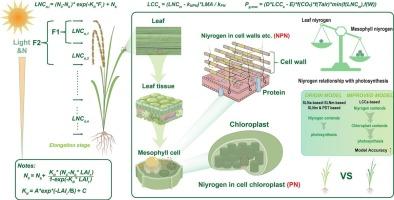Bridging chlorophyll content and vertical nitrogen distribution for accurate canopy photosynthesis simulation
IF 8.9
1区 农林科学
Q1 AGRICULTURE, MULTIDISCIPLINARY
引用次数: 0
Abstract
Accurate simulation of canopy photosynthesis is essential for predicting dry matter accumulation and crop yield. However, most current crop models overlook the effect of vertical distribution of leaf nitrogen and chlorophyll content on photosynthetic capacity at different canopy layers, resulting in greater uncertainties and weaker mechanistic explanation. Here, we developed a novel canopy photosynthesis model that establishes a bridge between chlorophyll content and photosynthetic nitrogen (PN, defined as total leaf nitrogen minus non-photosynthetic nitrogen) across different canopy heights, and then employs chlorophyll content as a reliable proxy forsimulating photosynthesis. The model was calibrated and validated using data from five field experiments under diverse treatments. Results indicate that leaves at higher canopy positions, receiving more light, contain higher nitrogen content and chlorophyll to support greater photosynthetic rates. The nitrogen extinction coefficient (KN), which characterizes the decline in available of leaf nitrogen, decreases exponentially with increasing LAI, varying among canopy depths, cultivars and growth stages. Chlorophyll shows a stronger correlation with photosynthesis compared to leaf nitrogen. By capturing these dynamics, the model enhances the accuracy of photosynthesis prediction by 60%, particularly correcting the overestimation of canopy photosynthesis and dry matter accumulation during post-flowering. These findings advance the understanding and modelling of canopy-scale photosynthesis in crop models and provide insights for better integration with chlorophyll-related remote sensing data.

桥接叶绿素含量和垂直氮分布以精确模拟冠层光合作用
准确模拟冠层光合作用对预测干物质积累和作物产量至关重要。然而,目前大多数作物模型忽略了叶片氮含量和叶绿素含量垂直分布对不同冠层光合能力的影响,导致不确定性较大,机制解释较弱。在此,我们建立了一个新的冠层光合作用模型,在叶绿素含量和光合氮(PN,定义为叶片总氮减去非光合氮)之间建立了一座桥梁,然后将叶绿素含量作为模拟光合作用的可靠代理。利用5个不同处理的田间试验数据对模型进行了校准和验证。结果表明,冠层位置越高,叶片接受的光照越多,氮含量和叶绿素含量越高,从而支持较高的光合速率。氮素消光系数(KN)随叶面积指数(LAI)的增加呈指数递减,随冠层深度、品种和生育期的变化而变化。与叶片氮相比,叶绿素与光合作用的相关性更强。通过捕获这些动态,该模型将光合作用的预测精度提高了60%,特别是纠正了花后冠层光合作用和干物质积累的高估。这些发现促进了对作物模型中冠层尺度光合作用的理解和建模,并为更好地整合叶绿素相关遥感数据提供了见解。
本文章由计算机程序翻译,如有差异,请以英文原文为准。
求助全文
约1分钟内获得全文
求助全文
来源期刊

Computers and Electronics in Agriculture
工程技术-计算机:跨学科应用
CiteScore
15.30
自引率
14.50%
发文量
800
审稿时长
62 days
期刊介绍:
Computers and Electronics in Agriculture provides international coverage of advancements in computer hardware, software, electronic instrumentation, and control systems applied to agricultural challenges. Encompassing agronomy, horticulture, forestry, aquaculture, and animal farming, the journal publishes original papers, reviews, and applications notes. It explores the use of computers and electronics in plant or animal agricultural production, covering topics like agricultural soils, water, pests, controlled environments, and waste. The scope extends to on-farm post-harvest operations and relevant technologies, including artificial intelligence, sensors, machine vision, robotics, networking, and simulation modeling. Its companion journal, Smart Agricultural Technology, continues the focus on smart applications in production agriculture.
 求助内容:
求助内容: 应助结果提醒方式:
应助结果提醒方式:


